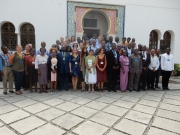In the summer of 2015, in addition to conducting fieldwork and research in the National museum of Ethiopia, I had the opportunity to participate in the 5th Biennial Conference of the EAAPP (East African Association for Paleoanthropology and Paleontology). The conference was held from the 3rd -6th of August 2015, with the theme “Fifty years after Homo habilis,” and it took place in the National Museum and House of Culture in Dar Es Salaam, Tanzania.
Established 10 years ago mainly by East African scientists from Tanzania, Kenya and Ethiopia, the EAAPP is an association with the aim of uniting researchers in the fields of paleontology and paleoanthropology. In addition to the scientific aspect, the association is unique in that it has a goal of creating an impact in the development of policies and promoting tourism, education and capacity building in East Africa. The association facilitates research activities that benefit housing institutions and engage the local community by creating awareness about cultural and paleontological heritages, thereby creating a sense of ownership that has the potential to impact the conservation of these resources.
The three-day conference was comprised of scientific sessions divided into paleontology, paleoenvironments, paleoanthropology, archeology, cultural heritage management and a special addition this year of INQUA carnivore sessions. Conference participants included not only Africans but also international researchers from different research and academic institutes. As it was mentioned in the conference, more than 60% of the papers presented had East African researchers as first authors. This is a very good opportunity for young East African researchers as it represents a forum for communicating science without the necessity of traveling abroad, which can be challenging for students from developing countries.
The end of the scientific sessions was followed by discussions on improving the process of conducting research such as acquiring research permits and conducting field work at heritage sites. There was an open discussion for young scientists to discuss challenges and opportunities in pursuing higher level educational training and conducting research in-region. It was very interesting to hear some success stories about how creating a good network at previous EAAPP conferences had enabled some students to accomplish master’s and PhD level training within their respective regions and abroad. The forum was also very helpful in that it tapped into a network of museum directors and administrative staff in order to discuss the challenges that graduate students face when pursuing research activities in the region such as having access to paleontological, archeological and prehistoric collections. At the end of the conference the participants had the rare opportunity to visit paleontological collections including original fossil specimens “Zinj”, OH-24, and OH-7, which have contributed greatly to our understanding of human evolution.
CASHP was represented by Kathryn Ranhorn, Professor Alison Brooks and me. Dr. Brooks gave an interesting keynote speech which related to the theme of the 2015 conference by discussing the paleontological, chronological and paleoanthropological thoughts at the time of discovery of H. habilis fifty years ago. Her talk emphasized the importance of the growing scientific knowledge in the area that has greatly changed our understanding of human origins, and shared recent research hailing from nearby locales such as Aduma, Middle Awash, Ethiopia and Olorgesailie, Kenya.
As an East African, I believe that the association is doing a very good job in bringing East African researchers together and communicating scientific findings about research conducted in East Africa and in Africa in general. Participating in the conference has helped me to create a good network with fellow East Africans and be better informed about the different paleontological, archeological and prehistoric sites and their active research programs. As the next conference in 2017 will be in Ethiopia, the country of my origin, I look forward to hearing about all the new and exciting scientific findings from the region and to personally welcoming members and participants of the 6th EAAPP to the cradle of mankind.



